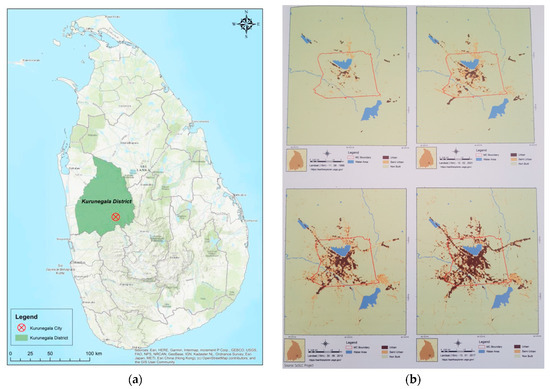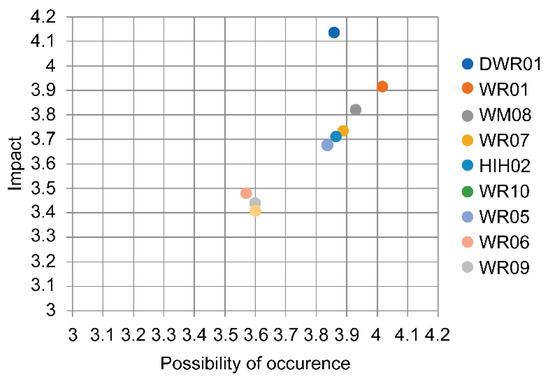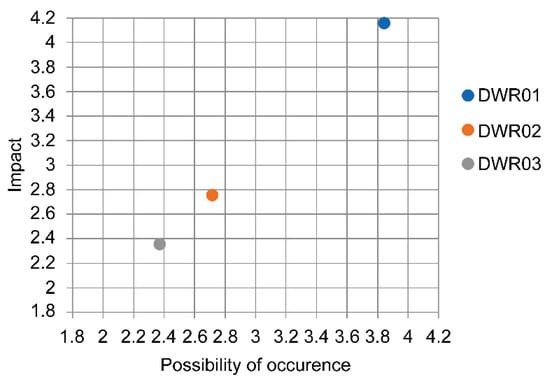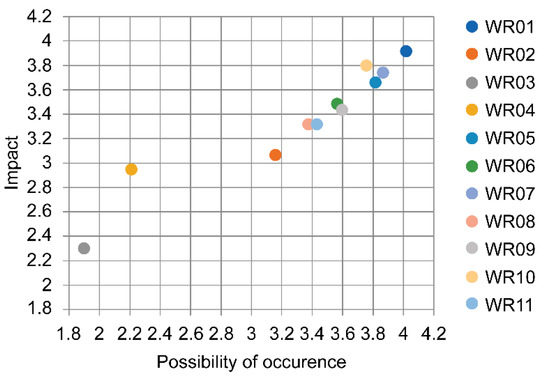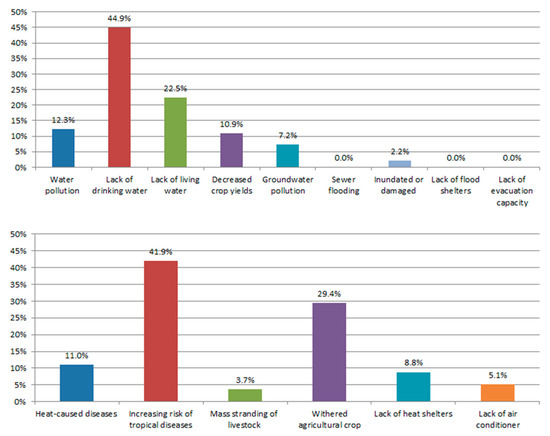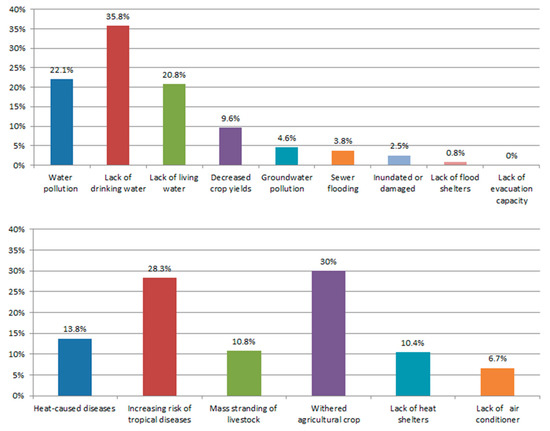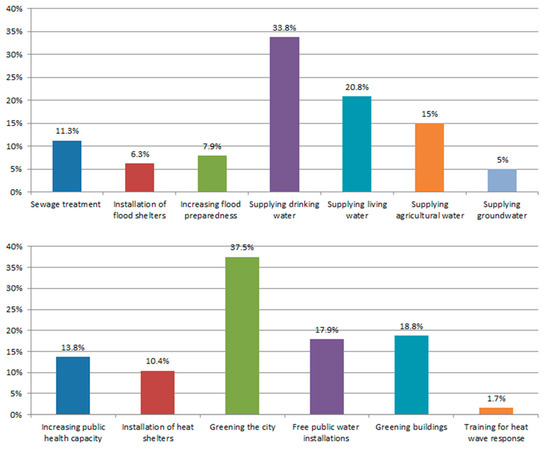Climate Change Risk Assessment for Kurunegala, Sri Lanka: Water and Heat Waves
Abstract
1. Introduction
2. Materials and Methods
2.1. Step 1: Establish the Context
2.2. Step 2: Identify the Risks
- Drinking water resources risk/vulnerability to drought (DWR); Risk or vulnerability on sources of useful or potentially useful portable water
- Water management risk/vulnerability (WM); Risk or vulnerability on water management that is the control and movement of water resources to minimize damage to life and property and to maximize efficient, beneficial use
- Water quality and aquatic ecosystems (WQAE); Risk or vulnerability on water quality and the condition or health of waterways, like rivers, wetlands
- Water resources risk/vulnerability (WR); Risk or vulnerability on resource of water that is useful or potentially useful, for agricultural, industrial, household, recreational and environmental activities
- Sanitation risk/vulnerability to droughts and floods (SDF); Risk or vulnerability on sanitation, which is the process of keeping places clean and healthy, especially by providing a sewage system and a clean water supply, due to drought and flood
- Health risk/vulnerability to floods (HF); Risk or vulnerability of health that is impacted by flood
- Health and infrastructure risk/vulnerability to heat stress (HIH); Risk or vulnerability on health and infrastructure that is impacted by heat stress and drought
2.3. Step 3: Analyze the Risks
2.4. Step 4: Evaluate the Risks
3. Results
3.1. Survey-Based Approach Assessment with Experts
3.2. Climate Change Awareness Survey
3.2.1. Climate Change Awareness Survey: Stakeholders
3.2.2. Climate Change Awareness Survey: Women
4. Discussion
5. Conclusions
Funding
Conflicts of Interest
Appendix A. Risk Factors for Each Indicator for Survey-Based Approach Assessment and Experts Survey Result
References
- UNDDR. Disaster Risk Reduction in Sri Lanka Status Report 2019. Available online: https://www.unisdr.org/files/68230_10srilankadrmstatusreport.pdf (accessed on 9 September 2020).
- De Costa, W.A.J.M. Climate Change in Sri Lanka: Myth or Reality? Evidence from Long-Term Meteorological Data. J. Natl. Sci. Found. Sri Lanka 2008, 36, 63–88. [Google Scholar] [CrossRef][Green Version]
- Germanwatch. Global Climate Risk Index 2020. Available online: https://germanwatch.org/en/17307 (accessed on 9 September 2020).
- Ministry of Irrigation and Water Resourced and Disaster Management. Summary Situation Report Sri Lanka. Available online: https://reliefweb.int/sites/reliefweb.int/files/resources/20180528_Sri_Lanka_Situation_Impact_1200hours_Final__1527495971.pdf (accessed on 9 September 2020).
- UN Habitat. State of Sri Lankan Cities. Available online: https://unhabitat.org/the-state-of-sri-lankan-cities-2018-report (accessed on 9 September 2020).
- WB Homepage. Available online: https://www.worldbank.org/en/country/srilanka/overview (accessed on 9 September 2020).
- Urban Development Authority. Development Plan for Urban Development Area of Kurunegala; Urban Development Authority: Battaramulla, Sri Lanka, 2006.
- Government of the Democratic Socialist Republic of Sri Lanka; UNDP. Maps Approach Supporting SDG Implementation in Sri Lanka. Available online: https://www.lk.undp.org/content/srilanka/en/home/library/undp-sri-lanka-publications-and-factsheets/MAPS2018.html (accessed on 27 November 2020).
- Bollin, C.; Cárdenas, C.; Hahn, H.; Vatsa, K. Disaster Risk Management by Communities and Local Governments. Available online: http://publications.iadb.org/handle/11319/4642 (accessed on 9 September 2020).
- City of Vancouver. Climate Change Adaptation Strategy. Available online: https://vancouver.ca/files/cov/Vancouver-Climate-Change-Adaptation-Strategy-2012-11-07.pdf (accessed on 9 September 2020).
- City of Melbourne. Climate Change Adaptation Strategy. Available online: https://www.melbourne.vic.gov.au/SiteCollectionDocuments/climate-change-adaptation-strategy.pdf (accessed on 9 September 2020).
- City of Copenhagen. Copenhagen Climate Adaptation Plan. Available online: https://en.klimatilpasning.dk/media/568851/copenhagen_adaption_plan.pdf (accessed on 9 September 2020).
- LTS International and Acclimatize. Government of Kenya Adaptation Technical Analysis Report. Available online: https://environmentalmigration.iom.int/government-kenya-adaptation-technical-analysis-report (accessed on 9 September 2020).
- Morsch, A. A Climate Change Vulnerability and Risk Assessment for the City of Atlanta. Master’s Thesis, Duke University, Durham, NC, USA, 2010. Available online: https://dukespace.lib.duke.edu/dspace/bitstream/handle/10161/2157/Masters%20Project%20by%20Amy%20Morsch.pdf?sequence=1 (accessed on 27 November 2020).
- UNISDR. National Disaster Risk Assessment—Governance System, Methodologies, and Use of Results. 2017. Available online: https://www.unisdr.org/files/52828_nationaldisasterriskassessmentwiagu.pdf. (accessed on 29 September 2020).
- The City of Windsor. Draft Climate Change Adaptation Plan. Available online: https://www.citywindsor.ca/residents/environment/documents/climate%20change%20adaptation%20plan.pdf (accessed on 2 November 2020).
- Basudeb, B. Causes and Consequences of Urban Growth and Sprawl. Analysis of Urban Growth and Sprawl from Remote Sensing Data. Advances in Geographic Information Science; Springer: Berlin/Heidelberg, Germany, 2012; Available online: https://doi.org/10.1007/978-3-642-05299-6_2 (accessed on 2 November 2020).
- WFP. Sri Lanka: Initial Assessment of Drought 2016/17. Available online: https://www.wfp.org/publications/Sri_Lanka_Drought_Assessment (accessed on 9 September 2020).
- Fussel, H.M.; Klein, R.J. Climate change vulnerability assessments: An evolution of conceptual thinking. Clim. Chang. 2006, 75, 301–329. [Google Scholar] [CrossRef]
- Kelly, P.M.; Adger, W.N. Theory and practice in assessing vulnerability to climate change and facilitating adaptation. Clim. Chang. 2000, 47, 325–352. [Google Scholar] [CrossRef]
- David, H.C.; Grant, S.S.; John, O.C.; Joe, C.S.; Nathan, R.T.; Xike, Z.; Jacqui, W.; Greg, M.M. The Climtae Change Risk Management Matrix for the Grazing Industry of Northern Australia. Rangel. J. 2009, 31, 31–49. [Google Scholar] [CrossRef][Green Version]
- Suraje, D.; Mike, H. Does Climate Policy Need Probabilities? Tyndall Centre Working Paper No. 34. Available online: https://www.researchgate.net/publication/245968397_Does_climate_adaptation_policy_need_probabilities (accessed on 2 November 2020).
- Ministry of Environment of Korea. Guidelines for Establishing LAP to Climate Change (Korean); Ministry of Environment of Korea: Sejong, Korea, 2013.
- City of Busan. Second Climate Change Adaptation Plan of Busan (Korean); City of Busan: Busan, Korea, 2016. [Google Scholar]
- City of Daegu. Second Climate Change Adaptation Plan of Daegu (Korean); City of Daegu: Daegu, Korea, 2016. [Google Scholar]
- City of Daejeon. Second Climate Change Adaptation Plan of Daejeon (Korean); City of Daejeon: Daejeon, Korea, 2016. [Google Scholar]
- City of Incheon. Second Climate Change Adaptation Plan of Incheon (Korean); City of Incheon: Incheon, Korea, 2016. [Google Scholar]
- City of Gwangju. Second Climate Change Adaptation Plan of Gwangju (Korean); City of Gwangju: Gwangju, Korea, 2016. [Google Scholar]
- City of Ulsan. Second Climate Change Adaptation Plan of Ulsan (Korean); City of Ulsan: Ulsan, Korea, 2016. [Google Scholar]
- IPCC. Climate Change 2014: Summary for Policymaker. Available online: https://www.ipcc.ch/site/assets/uploads/2018/02/ar5_wgII_spm_en.pdf (accessed on 27 November 2020).
- Aguilar, L. Gender Perspectives on Climate Change. In Proceedings of the 52nd Session of the Commission on the Status of Women, New York, NY, USA, 25 February–7 March 2008; Available online: http://www.gdnonline.org/resources/Aguilar_CSWgender-climatechange.pdf (accessed on 9 September 2020).
- NEST (Nigerian Environmental Study/Action Team). Gender and Climate Change Adaptation: Tools for Community-Level Action in Nigeria. Available online: https://genderinsite.net/sites/default/files/BNRCC-Gender-Toolkit.pdf (accessed on 9 September 2020).
- CTCN. Literature Review Report, Climate Technology Centre and Network (CTCN) Technical Assistance for the Development of an Urban Adaptation Plan for Kurunegala. Available online: https://www.ctc-n.org/system/files/dossier/3b/D3%20Literature%20review%20report.pdf (accessed on 9 September 2020).
- Asian Development Bank. Sri Lanka Water Supply and Sanitation Sector. Achievements and a Way Forward. Available online: https://www.adb.org/publications/sri-lanka-water-supply-and-sanitation-sector-achievements-way-forward (accessed on 9 September 2020).
- Greater Kurunegala Water Supply & Sewerage Project. Identification Report of Kurunegala Water Supply System; Project Monitoring Unit, Greater Kurunegala Water Supply & Sewerage Project: Kurunegala, Sri Lanka, in press.
- Wouter, P.; Ding, A.; Eberhard, M.; Derlon, N.; Desmond, P.; Burkhardt, M.; Wu, B.; Fane, A.G. Gravity-Driven Membrane Filtration for Water and Wastewater Treatment: A Review. Water Res. 2019, 149, 553–565. [Google Scholar] [CrossRef]
- European Commission. Nature-Based Solutions. Available online: https://ec.europa.eu/research/environment/index.cfm?pg=nbs (accessed on 9 September 2020).
- UN Environment Programme. Nature-Based Solutions for Climate. Available online: https://www.unenvironment.org/nature-based-solutions-climate (accessed on 9 September 2020).
- United Nations Global Compact. Nature-Based Solutions to Address Climate Change. Available online: https://www.unglobalcompact.org/take-action/events/climate-action-summit-2019/nature-based-solutions (accessed on 9 September 2020).
- Di Cristo, R.; Mazzarella, A.; Viola, R. An analysis of heat index over Naples (Southern Italy) in the context of European heat wave of 2003. Nat. Hazards 2007, 40, 373–379. [Google Scholar] [CrossRef]
- Manjula, R.; Sujith, S.R.; Dmslb, D.; Lalit, K.; Hasula, W.; Jagathdeva, V.; Hanna, C.; Susantha, U.; Keshav, K.J.; Matamyo, S.; et al. Spatiotemporal Variation of Urban Heat Islands forImplementing Nature-Based Solutions: A Case Study of Kurunegala, Sri Lanka. ISPRS Int. J. Geo Inf. 2020, 9, 461. [Google Scholar] [CrossRef]
- Dissanayake, D.; Morimoto, T.; Ranagalage, M.; Murayama, Y. Land-Use/Land-Cover Changes and Their Impact on Surface Urban Heat Islands: Case Study of Kandy City, Sri Lanka. Climate 2019, 7, 99. [Google Scholar] [CrossRef][Green Version]
- Estoque, R.C.; Murayama, Y. Monitoring Surface Urban Heat Island Formation in a Tropical Mountain City Using Landsat Data (1987–2015). ISPRS J. Photogramm. Remote Sens. 2017, 133, 18–29. [Google Scholar] [CrossRef]
Publisher’s Note: MDPI stays neutral with regard to jurisdictional claims in published maps and institutional affiliations. |
© 2020 by the author. Licensee MDPI, Basel, Switzerland. This article is an open access article distributed under the terms and conditions of the Creative Commons Attribution (CC BY) license (http://creativecommons.org/licenses/by/4.0/).



